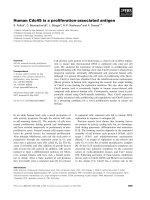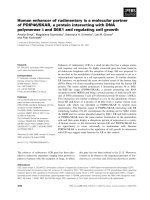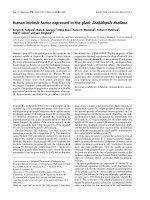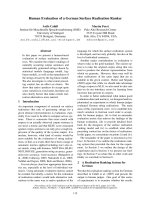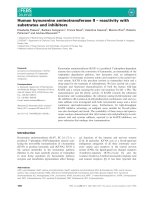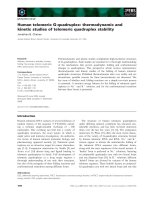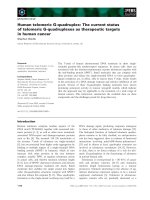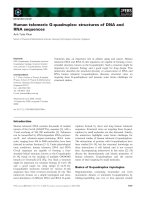báo cáo khoa học: " Human serum-derived hydroxy long-chain fatty acids exhibit anti-inflammatory and anti-proliferative activity" pot
Bạn đang xem bản rút gọn của tài liệu. Xem và tải ngay bản đầy đủ của tài liệu tại đây (2.68 MB, 13 trang )
RESEARC H Open Access
Human serum-derived hydroxy long-chain fatty
acids exhibit anti-inflammatory and
anti-proliferative activity
Shawn A Ritchie
1*
, Dushmanthi Jayasinghe
1
, Gerald F Davies
1,2
, Pearson Ahiahonu
1
, Hong Ma
1
and
Dayan B Goodenowe
1
Abstract
Background: Circulating levels of novel long-chain hydroxy fatty acids (called GTAs) were recently discovered in
the serum of healthy subjects which were shown to be reduced in subjects with colorectal cancer (CRC),
independent of tumor burden or disease stage. The levels of GTAs were subsequently observed to exhibit an
inverse association with age in the general population. The current work investigates the biological activity of
these fatty acids by evaluating the effects of enriched human serum extracts on cell growth and inflammation.
Methods: GTAs were extracted from commercially available bulk human serum and then chromatographically
separated into enriched (GTA-positive) and depleted (GTA-negative) fractions. SW620, MCF7 and LPS stimulated
RAW264.7 cells were treated with various concentrations of the GTA-positive and GTA-negative extracts, and the
effects on cell growth and inflammation determined.
Results: Enriched fractions resulted in poly-ADP ribose polymerase (PARP) cleavage, suppression of NFB, induction
of IBa, and reduction in NOS2 mRNA transcript levels. In RAW264.7 mouse macrophage cells, incubation with
enriched fractions prior to treatment with LPS blocked the induction of several pro-inflammatory markers including
nitric oxide, TNFa, IL-1b, NOS2 and COX2.
Conclusions: Our results show that human serum extracts enriched with endogenous long-chain hydroxy fatty
acids possess anti-inflammatory and anti-proliferative activity. These findings support a hypothesis that the
reduction of these metabolites with age may result in a compromised ability to defend against uncontrolled cell
growth and inflammation, and could therefore represent a significant risk for the development of CRC.
Keywords: Long-chain fatty acid colorectal cancer, aging, screening, inflammation, NFκB
Background
Fatty acid metabolism is intricately linked to the regula-
tion of inflammatory processes, which underlie numer-
ous diseases including cancer. For example , arachidonic,
decosahexanoic and eicosapentanoic acids (AA, DHA
and EPA) can be metabolized into both pro-inflamma-
tory prostaglandins and leukotrienes, as well as into
inflammation-resolving lipoxins, protectins and resolvins
[1-3]. The failure to resolve acute inflammation through
a lack of conversion to these latter products can result
in a chronic inflammatory state, which over time can
drive the development of inflammation-associated con-
ditions including cancer, neurodegeneration, and othe rs
[4-10]. Functionally, many of these lipids have been
shown to mediate their inflammation-associated effects
through pathways involving the transcription factor
NFBandsubsequentdownstream pro-inflammatory
molecules such as TNFa,IL-1b, COX2, and NOS2, for
example [11-16].
Recently we reported on a novel cla ss of hydroxylate d
long-chain fatty aci ds (called GTAs for gastrointestinal
tract acids) present in the serum of healthy subjects and
significantly reduced from the serum of colorectal canc er
(CRC) patients [17,18]. Structurally, the molecules resem-
ble very long chain (28 carbon) mimetics of the resolvins
* Correspondence:
1
Phenomenome Discoveries, Inc. Saskatoon, Saskatchewan, Canada
Full list of author information is available at the end of the article
Ritchie et al. Journal of Experimental & Clinical Cancer Research 2011, 30:59
/>© 2011 Ritchie et al; licensee BioMed Central Ltd. This is an Open Access article distributed under the terms of the Creative Commons
Attribu tion License ( which permits unres tricted use, distribution, and reproduction in
any medium, provided the original work is properly cited.
and protectins, containing multiple double bonds and at
least two hydroxyl groups. The levels of GTAs do not
change following treatment and show no correlation with
tumor stage, suggesting th at the reduction is not caused
by the presence of the disease [17,18]. An inverse associa-
tion between GTAs and age in the average-risk population
further suggests that the reduction exists prior to cancer
development, and may therefore represent a causal factor
for the establishment and/or progression of the disease
[18]. However, little is currently known a bout the bio-
chemical role these molecules play in the disease process.
The work reported herein, therefore, was carried out to
investigate the effects of GTAs in vitro through the treat-
ment of various cell lines w ith semi-purified GTA-
enriched human serum extracts.
Methods
Cell lines and tissue culture
SW620, MCF-7 and RAW264.7 were purchased from
ATCC and cultured in high glucose DMEM, 10% FBS at
37°C, 5% CO
2
. Cells were seeded at 1 × 10
6
/well in 6-
well plates 24 hours prior to treatment with varying
concentrations of GTA+ve extract, GTA-ve extract or
vehicle (DMSO). RAW264.7 cells were pretreated with
the extract s for 4 hours followed by the additi on of L PS
at 1 ug/ml (cat. No. L4391, Sigma) for 20 hours. Cells
were har vested using a 2:1 ratio of Versene and TryPLe
express (Gibco). The cell pellet was washed twice with
phosphate buffered saline (PBS) and the stored at -80°C
until extracted. Cell photographs were taken at 200×
magnificatio n on a phase- contrast EVOS digital micro-
scope. All experiments were performed at least three
times in duplicate or triplicate wells.
Serum extraction, chromatography and mass
spectrometry
Commerci ally available lyopholized human serum (Ran-
dox Laboratories, Canada) was resolubilized in double
de-ionized water. The serum was extracted with 1:5
ratio of 1% ammonium hydroxide:ethyl acetate (Com-
mercial grade, VWR) as previously described [17]. Ethyl
acetate extracts were evaporated to dryness under
reduced pressure (37°C/100 rpm) and re-suspended in
methanol. Reverse phase silica (15 - 20 mg; WP C18
silica, 45 μm, 275 Å) was added into the serum metha-
nol extract and evaporated to complete dryness under
reduced pressure (45°C/150 rpm), which w as then sub-
jected to reverse phase flash column chromatography
(FCC) with a step gradient elution; acetonitrile - water
25:75 to 100% acetonitrile. Eluent was fractionated into
12 aliquots (F1 - F12), which were each analysed for
GTA content using HPLC-coupled tandem mass spec-
trometry on an ABI QSTAR XL mass spectrometer as
previously described [17].
Proliferation assays
Cell proliferation was determined using the MTT assay
(3-(4,5-dimethylthiazol-2-yl)-2,5-diphenyltetrazolium
bromide). Cell suspensions were prepared at a concen-
tration of approximately 10
5
cells per ml as determined
by standard hemocytometry, and cultured in 6-well
multi-well plates. Prior to MTT analysis, cells were sub-
cultured in phenol red-free DMEM medium to avoid
interference with the colorimetric analysis of the purple
formazan MTT product. Following treatment with
serum extracts, cells were treated with MTT followed
by washing with PBS, DMSO solubilization of the for-
mazan product, and subjected to spectrophotometric
analysis at 570 nm.
Protein analysis
Cell pellets were resuspended in ice- cold lysis buffer (20
mM Tris (pH 7.5), 150 mM NaCl, 0.5 mM EDTA, 0.1
mM EGTA, 0.1% NP-40 plus 1X mammalian cell anti-
protease cocktail (Sigma)). The cells were lysed using mul-
tiple fre eze-thaw cycles followed b y pulse sonication on
ice and centrifugation at 3000 rpm fo r 5 minutes at 4°C
to remove cell debris. Western blot analysis of these pro-
tein lysates was performed as previously described [19].
Briefly, equivalent amounts of protein were assessed by
Bradford protein assay using BioRad Protein Reagent and
resolved by 10% sodium dodecyl sulfate-polyacrylamide
gel electrophoresis (SDS-PAGE). Following electrophor-
esis the proteins were trans-blotted onto nitrocellulose
membranes (Pall-VWR). The membranes were blocked
overnight at 4°C on a gyratory plate with 5% molecular
grade skim milk powder (BioRad Laboratories) in phos-
phate-buffered saline (PBS) containing 0.1% Tween-20
(PBST). Primary and secondary antibody incubations and
subsequent w ashes were carried out in the same buffer.
Primary antibodies were obtained from Santa Cruz Bio-
technology. The primary antibody for GAPDH was pur-
chased from Sigma. Secondary HRP antibodies were
purchased from BioRad. Blots were immunoprobed over-
night with primary antibodies at a 1:1000 dilution. Sec-
ondary HRP antibody was applied at room temperature
on a gyratory plate at a concentration of 1:10,000 for 30
min. Following multiple washes, an enhanced chemilumi-
nescence detection system (Dupont-NEN) was used to
detect the target antigen/antibody complexes. Blots were
then stripped at 50°C for 30 minutes in a Tris-buffered
20% SDS/1% 2-mercaptoethanol stripping solution,
washed and re-probed with GAPDH antibody (Sigma) to
verify protein loading equivalency. For ELISA analysis,
raw cells were treated as described above and conditioned
medium or cell lysates were used to determine concentra-
tions of TNFa (Cat. No. KMC3011, Invitrogen), and I L-
1b (Cat. No. MLB00B, Quantikine), according to the man-
ufacturer’s instructions.
Ritchie et al. Journal of Experimental & Clinical Cancer Research 2011, 30:59
/>Page 2 of 13
Nitric oxide assay
Nitrite concentration in conditioned media was mea-
sured by Griess Reagent (Cat. No. G2930, Promega)
according to the manufacturer’s instructions.
Quantitative Real-Time PCR
Total RNA was isolated from cell pellets using Trizol
(Cat. No.15596-018, Invitrogen) as per manufacturer’ s
instruction. RNA was resuspended in 50 μL of DEPC
treated water and stored at -80°C. RNA concentration
and purity was determined by spectrophotometry at 260
and 280 nm. Revers e transcription was performed using
qScript cDNA super mix (Cat No. 95048-100, Quanta
Biosciences). PCR was conducted by using Fast SYBR
Green Master Mix (Cat No. 4385612, AB Applied Bio-
systems) on an A pplied Biosystems Step One Plus Real-
time PCR system. The relative number of each tran-
script copy was normalized by house-keeping gene Beta
Actin. Real -time PCR primers used w ere as follows:
NOS2 forward, CACCTTGGAGTTCACCCAGT; NOS2
reverse, ACCACTCGTACTTGGGATGC; COX2 for-
ward, CCCCCACAGTCAAAGACACT; COX2 reverse,
CTCATCACCCCACTCAGGAT; TNFa forward, AG
AAGTTCCCAAATGGCCTC; TNFa reverse, GTC
TTTGAGATCCATGCCGT; IL-1b forward, TGTGA
AATGCCACCTTTTGA; IL-1b reverse, TGAGTG
ATACTGCCTGCCTG.
Clinical Samples
Serum from a previously reported CRC patient and con-
trol population originating from Chiba University was
equ ally pooled [17]. Ethyl-acetate extracts of the pooled
control and CRC serum were subject to HPLC-coupled
tandem mass spectrometry to determine relative GTA
levels as previously described [17].
Statistical Methods
Where data is averaged, error bars represent 1 stan dard
deviation (S.D.) of the mean. Significance was deter-
mined if p < 0.05 using unpaired Student’ sTtest
(Microsoft Excel).
Results
Treatment of cells with un-enriched human serum
extracts
We first determined whether crude serum ethyl acetate
extract, prior to chromatographic enrichment of GTAs,
would have any effect on cellular growth by treating
cells with commercially available bulk human serum
extracts (see methods). The total ion chromatogram
(TIC) of the organic fraction following HPLC-coupled
time-of-flight (TOF) mass spectrometry is shown in Fig-
ure 1A. The extracted mass spectra of the complete TIC
is shown in Figure 1B, which was dominated by various
free fatty acids but contained detectable levels of GTAs
including those with masses of 446 (C28H46O4), 448
(C28H48O4) and 450 (C28H50O4) Da (Figures 1B and
1C). By calculating the peak areas of the three chroma-
tograms, we estimated that these three GTAs repre-
sented no more than 0.15% of the total ion current in
the sample. Incubation of SW620 cells with up to 80
ug/ml of the extract for 48 hours showed no effect on
cell proliferation (Figure 1D) or an y effect s on cell mor-
phology as assessed by light microscopy (not shown).
Organic serum extract was next subjected to flash col-
umn chromatography as described in the methods,
resulting in 12 fractions which were subsequently ana-
lyzed by HPLC-MS to determine GTA content.
Although other components were present in all the frac-
tions, only fraction 9 out of the 12 was enriched for the
C28GTAs(referredtoastheGTA+vefraction).A
GTA negative control fraction (fraction 8, lacking any
detectable GTAs) was also selected for the studies
described below. Representative total ion chromato-
gram s, extracted mass spectra and selected ion chroma-
tograms of the three C28 GTAs for the GTA-ve and
GTA+ve fractions are shown in Figures 2A and 2B,
respectively. By comparing the sums of the selected ion
chromatograms of the three GTAs to the total i on cur-
rents, we estimated that the GTA+ve fraction contained
approximately 21% C28 GTAswhiletheGTA-vefrac-
tion had no detectable levels (bottom panel of Figures
2A and 2B). The non-GTA background components for
both fractions were similar, and the most abundant
non-GTA components in the GTA+ve fraction were
also the most abundant components in the GTA-ve
fraction. Therefore, the two fractions were composition-
ally similar other than the 21% GTA c ontent of the
GTA+ve fraction, which represented an approximately
143-fold enrichment of the three C28 GTA metabolites
over the crude organic serum extract (a s shown in Fig-
ure 1A). These fractionations were repeated several
times with consistent results. We therefore concluded
that the fractions were sufficiently matched for investi-
gating biological activity as described below. For com-
parison, the relative levels of the three C28 GTAs from
40 pooled CRC patients’ serum and serum from 40
matched control subjects is shown in Figure 2C.
GTA+ve human serum extracts inhibit cell proliferation
and induce PARP fragmentation
We determined whether the enriched GTA+ve fraction
had any effects on cell viability compared to the GTA-
ve fraction by treating SW620 cells for 24 hrs with three
concentrations of each fraction and measuring the effect
on cell proliferation by MTT assay. The GTA+ve frac-
tion showed a 40% reduction in cell viability at a dose
of 80 ug/ml (Figure 3A) while GTA-ve treatment had
Ritchie et al. Journal of Experimental & Clinical Cancer Research 2011, 30:59
/>Page 3 of 13
no effect. Treatment up to 48 hrs using 80 ug/ml
showed the same 40% reduction as early as 12 hrs,
which dropped further to 70% by 48 hrs (Figure 3B). No
effect on cell proliferation was observed with the GTA-
ve fraction or vehicle (DMSO). Evidence of apoptotic
activity was determined by the detection of poly(ADP-
ribose) polymerase (PARP) cleavage products through
Western blot (Figure 3C). A number of PARP cleavage
products including the hallmark 89 and 24 kDa frag-
ments, as well as others (Figure3C),wereinducedfol-
lowing 48 hrs treatment with GTA+ve fraction, but not
with GTA-ve treatment, suggesting a possible pro-apop-
totic function of GTAs.
We repeated the studies in MCF7 cells, which upon
treatment with GTA+ve f raction showed gross cellular
changes visible through phase-contrast microscopy
including the appearance of apoptosomes and enlarged
nuclei that were not observed with vehicle or GTA-ve
treatments (Figures 4A, B and 4C). GTA+ve treatment
in MCF-7 cells also resulted in the exclusive induction
of the 24 kDa PARP cleavage product relative to vehi-
cle or GTA-ve treatment (Figure 4D), further suggest-
ing a pro-apoptotic activity of GTA-containing
extracts.
GTA+ve extracts inhibit pro-inflammatory markers
The structural resemblance of GTAs to the inflamma-
tion-resolving protectins and resolvins prompted us to
investigate the effect of GTA+ve extract on pro-inflam-
matory markers. Treatment of SW620 cells for 24 hours
resulted in a profound inhibition of NFB protein level
with as little as 20 ug /ml GTA+ve extract, accompanied
by an equally profound induction of IBa,neitherof
which was observed with GTA-ve extract (Figure 5).
Protein levels of nitric oxide synthase (NOS2) were also
inhibited in cells treated with the GTA+ve fraction (par-
ticularly 20 and 40 ug/ml), but not in cells treated with
the GTA-ve fraction (Figure 5).
Figure 1 Total ion chromatogram of crude serum organic extract. (A) Total ion current of bulk serum following liquid/liquid extraction and
HPLC-coupled mass spectrometry as explained in the methods. (B) Extracted mass spectra of all masses from (A). (C) Extracted ion
chromatograms of GTAs 446, 448 and 450 from the total ion current shown in A. (D) Cell proliferation, as assayed by MTT, for SW620 cells
treated with up to 80 ug/ml of the crude serum extract.
Ritchie et al. Journal of Experimental & Clinical Cancer Research 2011, 30:59
/>Page 4 of 13
Figure 2 Mass spectrometry characterization of semi-pur ified GTA-ve and GTA+ve extracts. (A) Crude serum extract (as sh own in Figure
1) was subject to flash column chromatography as described in the methods resulting in two adjacent eluates, one positive and one negative
for the presence of GTAs. The total ion chromatogram (top), extracted mass spectra (middle), and extracted ion chromatograms for three GTAs
(GTA446, 448 and 450; bottom) of the GTA-ve fraction. (B) Same as (A) for the GTA+ve fraction. (C) For comparison, the extracted ion
chromatograms of GTA446, 448 and 450 from the extracts of serum pooled from 20 CRC patients and 20 controls is shown.
Ritchie et al. Journal of Experimental & Clinical Cancer Research 2011, 30:59
/>Page 5 of 13
To explore further the effect of GTAs on modulating
inflammation, we employed the RAW264.7 mouse
macrophage line in which a pro-inflammatory state
can be induced by treatment with lipopolysaccharide
(LPS). RAW264.7 cells were treated for 4 hours with
GTA+ve and GTA-ve fractions prior to the addition of
LPS, and the effects on various proinflammatory mar-
kers evaluated. We observed no affect on RAW264.7
cell growth or proliferation rates during the 20 hours
post-GTA treatment. RAW264.7 cells treated with
GTA+ve fractions prior to LPS stimulation showed a
significant dose-dependent reduction (p < 0.05) in the
generation of nitric oxide as assessed through the pro-
duction of nitrite using the Griess reagent system (Fig-
ure 6A), which was mirrored by low levels of NOS2
mRNA transcripts (Figure 6B) and protein levels (Fig-
ure 6C). For comparison (and as controls), cells were
also treated with various combinations of free fatty
acids including EPA, DHA and equimolar mixtures of
18:1, 18:2 and 18:3 (FA mix), of which only 100 uM
DHA showed any protective effect on NOS2 protein
induction (Figure 6C).
Similar effects were observed with TNFa upon treat-
ment with GTA+ve extract, which showed significantly
reduced mRNA transcript levels (p < 0.05, Figure 7A) as
well as protein levels in cell lysates and conditioned
media (Figures 7B and 7C, respectively). Consistent with
the above findin gs, transcript levels of COX2 and IL-1b
(Figures 8A and 8B), as well as IL-1b protein levels (Fig-
ure 8C), were also significa ntly reduced (p < 0.05) with
GTA+ve treatment. The results indicate that human
blood extracts containing GTAs have anti-proliferative
and anti-inflammatory properties that GTA-ve extracts
lack.
Figure 3 Proliferation of SW620 cells treated with GTA+ve and GTA-ve extracts. (A) SW620 cells were incubated with increasing
concentrations of GTA+ve and GTA-ve extracts for 24 hours and proliferation assayed by MTT. (B) The 80 ug/ml concentration of GTA+ve and
GTA-ve extracts was then used to treat cells for up to 48 hours and the effect on cell proliferation assayed by MTT. Data are expressed as
percent of vehicle or 0 hrs ± 1S.D. (C) Representative Western blot analysis of caspase-mediated PARP cleavage fragments resulting from
treatment with GTA+ve and -ve extracts. Experiments were repeated at least three times.
Ritchie et al. Journal of Experimental & Clinical Cancer Research 2011, 30:59
/>Page 6 of 13
Discussion
The regulation of inflammation and the ability to con-
trol cell growth are two processes intricately linked with
cancer. When acute inflammatory processes are not
resolved by the appropriate enzymatic conversion of
fatty acid mediators into specific oxygenated products
[1,20,21], a state of chronic inflammation can ensue,
which can further lead to sporadic DNA mutations, the
activation of pro-oncogenic pathways and ultimately
cancer (for example see [22]). When such detriments
occur, they normally trigger a cascade of intracellular
events leading to the induction of apoptotic-mediated
cell death. Thus it is the fine control between inflamma-
tory and a poptotic processes, likely early in life, which
mightbeakeydeterminantofone’sriskofsubsequent
cancer development.
Based on the tumor-independent reductio n of GTAs
previously reported in CRC patient serum [17], their
age-related reduction in the general population [18], and
their structural resemblance to the inflammation-resol-
ving protectins and resolvins, we hypothesized that
GTAs might represent a novel endogenous cancer-pro-
tective metabolic system. Although we focused
Figure 4 Treatment of MCF7 cells with GTA+ve and GTA-ve extracts. MCF7 cells were incubated with vehicle (A), 80 ug/ml GTA+ve extract
(B), and 80 ug/ml GTA-ve extract (C) and cells photographed using phase-contrast light microscopy (200×). (D) Western analysis of PARP
cleavage products; ns, non-specific.
Figure 5 West ern analysis of NFB, IBa and NOS2 in SW620
cells treated with three concentrations of GTA+ve and GTA-ve
extracts and doxorubicin (DOX). Representative Western blots
showing protein levels of NFB, IBa and NOS2 in SW620 cells
treated with GTA+ve and GTA-ve extracts (see methods).
Ritchie et al. Journal of Experimental & Clinical Cancer Research 2011, 30:59
/>Page 7 of 13
specifically on a subset of 28-carbon GTAs, the GTA
family comprises a large number of structurally related
novel hydroxylated polyunsaturated ultra long-chain
fatty acids ranging in size between 446 and 596 Da and
containing up to 36 carbons [17].
In studies completed to date, GTAs appear to repre-
sent a human-specific metabolic system as they have
only been detected in human serum (or plasma) and not
in the serum or plasma of other mammals including
mice, rats, cows, dogs, and rabbits. Likewise, GTAs are
Figure 6 Determination of nitric oxide status in RAW264.7 cells
treated with GTA+ve and GTA-ve extracts. RAW264.7 cells were
pre-treated for 4 hours with GTA+ve or GTA-ve extracts followed by
the addition of LPS (1 ug/ml) for 20 hours. (A) Nitric oxide levels in
cells were determined using Griess reagent, (B) NOS2 mRNA
transcript levels were determined by real-time rtPCR, and (C) NOS
protein (treatment with 80 ug/ml) assessed by Western blot (NS,
non-specific). Asterisks indicate p < 0.05 relative to LPS treatment
alone, and FA mix in (C) represents a 100 uM equal mixture of 18:1,
18:2 and 18:3 fatty acids. Data are expressed as the average of three
duplicate experiments ± 1S.D.
Figure 7 TNFa response in RAW264.7 cells treated with GTA
+ve and GTA-ve extracts. RAW264.7 cells were pre-treated for 4
hours with GTA+ve or GTA-ve extracts followed by the addition of
LPS (1 ug/ml) for 20 hours. (A) TNFa mRNA transcripts as
determined by real-time rtPCR, (B) TNFa relative protein levels in
cell lysates following 80 ug/ml treatment, and (C) TNFa protein
levels in conditioned media as determined by ELISA. Asterisks
indicate p < 0.05 relative to LPS treatment alone. Data are
expressed as the average of three duplicate experiments ± 1S.D.
Ritchie et al. Journal of Experimental & Clinical Cancer Research 2011, 30:59
/>Page 8 of 13
absent from several types of plant-based products such
as grains and seed oils, as well as human tissues includ-
ing colonic tumors and nor mal colon epithelium
(unpublished observations). This human exclusivity has
lead us to speculate that the gut microbiota, in
combination with currently unknown dietary precursors,
may be involved in their catabolism. The results shown
here represent the first report of GTA biological activity,
which revealed that cells treated with GTA+ve extracts
had reduced proliferative capacity coinciding with PARP
fragmentation, significantly down-regulated NFB
expression, increased IBa levels, and numerous down-
regulated inflammatory markers including nitric oxide,
NOS2, IL-1b,TNFa and COX2. Given the critical role
of NFB in regulating both apoptosis and inflammation
and its association with aging, our data suggests that the
protect ive effects of GTAs are mediated, at least in part,
through NFB signalling. A reduction of GTAs over
time could therefore be involved in compromising one’s
ability to protect against chronic inflammation and pos-
sibly cancer.
GTAs, fatty acids, and proliferation
Our observation that GTA+ve extracts dose-depen-
dently reduce cell proliferation, accompanied by the
appearance of multiple PARP cleavage products with
different molecular weights in SW620 cells but only
the 24 kDa fragment in MCF-7 cells, suggests a com-
plex cell-specific interplay between different proteases.
Although it has been reported that caspase-3 activation
can result in the 89 and 24 kDa fragments and that
cathepsin-b and granzyme-b can produce fragments of
50 and 64 kDa, respectively [23], further work will be
required to investigate GTA-specific protease activa-
tion. Our evidence of apoptosis upon treatment with
GTAs is consist ent with numerous other reports show-
ing pro-apoptotic effects mediated through polyunsatu-
rated long chain fatty acids (PUFAs). For example,
docosahexanaeoic acid (DHA) has been shown to pro-
mote apoptosis through nume rous pathways including
cytochrome-c mediated caspase activation [24,25], inhi-
bition of the regulatory subunit of PI3-kinase, and
reduction of PTEN phosphorylation [24,26]. Others
have shown that DHA and the PUFA punicic acid ulti-
mately exert their intrinsic effects through dissipation
of the mitochondrial membrane potential [27,28], and
that DHA and butyrate can promote apoptosis by
altering mitochondrial Ca
2+
levels [29]. Treatment of
various cell lines, for example LAPC-4 prostate cancer-
derivedcells,withPUFAs,hasbeenshowntoreduce
proliferation and induce ap optosis [30]. There are also
studies demonstrating the inhibitory effects of omega-3
PUFAs on growth and angiogenesis of chemically
induced as well as transplanted t umor model systems
[31-33]. The observation of reduced cell growth in the
presence of GTA+ve extract is therefore consistent
with a large body of literature sho wing similar effects
with exposure to long-chain PUFAs (see [34] for
review).
Figure 8 CO X2 and IL-1b response in RAW264.7 cells treated
with GTA+ve and GTA-ve extracts. RAW264.7 cells were pre-
treated for 4 hours with GTA+ve or GTA-ve extracts followed by the
addition of LPS (1 ug/ml) for 20 hours. (A) COX2 and (B) IL-1b
mRNA levels were determined by real-time rtPCR. (C) IL-1b levels
following 80 ug/ml treatment in cell lysates as determined by ELISA.
Asterisks indicate p < 0.05 relative to LPS treatment alone. Data are
expressed as the average of three duplicate experiments ± 1S.D.
Ritchie et al. Journal of Experimental & Clinical Cancer Research 2011, 30:59
/>Page 9 of 13
In addition to its anti-proliferative effect, GTA+ve
extract also protected against the LPS-mediated induc-
tion of several pro-inflammatory proteins including
TNFa,IL-1b, NOS2 and COX2, and inhibited the pro-
duction of nitric oxide. Central to these two effects
(reduced proliferation and inflammation) was the con-
comitant inhibition of NFB upon GTA+ve treatment
in SW620 colonic epithelial cells, which correlated pre-
cisely with increased levels of the inhibitory protein
IBa, likely due to stabilization stemming from compro-
mised ubiquitin-dependent proteosomal targeting [35].
The inhibition of NFB is relevant to both apoptotic
processes and inflammation, as discussed further below.
NFB and cell proliferation
NFB, a transcription factor represented by a se ries of
subunit s harbouri ng discrete DNA binding and transac-
tivational functionality, is implicated in both intrinsic
and extrinsic apoptotic pathways (see [36] for review)
and has been shown to prevent apoptosis as well as pro-
mote transformation in epithelial-derived cancers [37].
Mechani stically, in the absence of NFB signalling, inhi-
bitor-of-apoptosis proteins (IAPs) fail to suppress
assembly of the death-inducing complex II, which allows
for the TRADD-mediated activation of caspase-8 and
subsequent apoptosis [36,38]. Furthermore, IAPs can
directly promote the ubiquitin-mediated degradation of
the NFB-inducing serine/threonine kinase (NIK), ulti-
mately resulting in NFB activation [39]. Although a
detailed discussion on this topic is out of scope, it is
well established that activated NFB is associated with
an anti-apoptotic pro-survival advantage which is rele-
vant given our data showing that GTA+ve extracts
reduced NFB expressio n. These observations are con-
sistent with the reported biological activity of the resol-
vins and protectins, which have been shown to exert
both pro-apoptotic effects [40] and the resolution of
inflammation by attenuating cytokine levels in an
NFB-dependent manner [41]. One limitation of our
study was that we were unable to determine N FB
levels in RAW264.7 cells, which will require further
investigation upon the generation of sufficient quantities
of either enriched extract, or more preferably, purified
synthetic GTAs. Howe ver, the dramatic reducti on of
NFB upon GTA treatment in colon tumor cells is
highly relevant given the reduced levels of circulating
GTAs in CRC patients [17,18] and the well-established
inflammatory component of this disease [42].
NFB and inflammation
Besides its anti-apoptotic role, NFBrepresentsakey
link between inflammation and cancer (see [43] for
review), and in particular, is considered a master regula-
tor of intestinal immunological function and activator of
factors involved in driving intestinal inflammation
[44-46]. NFB activation has been observed in numer-
ous GI-related conditions including inflammatory bowel
disease [47], Crohn’s disease [48], ulcerative colitis [35],
inflamed intestinal mucosa [49] as well as CRC [50-53].
It has been shown that the NFB transcriptional activity
in gastric mucosa is induced during aging [53], that
positive NFB expression as assessed through immuno-
histochemistry is observed in 73.5% of human CRC
tumors independent of age [50], and that levels o f
NFB, IKKa and COX2 in tumor epithelial cells from
CRC patients are signi ficantly higher than adjace nt nor-
mal tissue [52].
Also relevant to NFB activation and intestinal inflam-
mation is the reported differential regulation of Toll-like
receptors (TLRs) by fatty acids with differing saturation
states [54-56]. TLRs are single membrane-spanning pro-
teins involved in the recognition of microbial-derived
molecules harbouring pathogen-associated molecular
patterns (PAMPs) and activation of various immune cell
responses [57]. Upon activation, TLRs activate NFB
though a complex signalling network culminating with
the activation of IKKa, followed by ubiquitination and
subsequent degradation of IBa and translocation of the
P65 Rel A domain to the nucleus where it binds to and
activates the expression of numerous pro-inflammatory
genes [44]. Specifical ly, TLR4 has been shown to confer
responsiveness to a number of lipids including lipid A,
the primary biologically active component o f LPS, and
that in contrast to saturated fatty acids similar to those
found in lipid A, unsaturated fatty acids inhibit NFB
activity through inhibition of TLR4 or other TLR-asso-
ciated molecules [55,56]. Therefore, it is possible that
the anti-inflammatory effects associated with GTAs are
being exerted through inhibition of TLRs upstream of
NFB. Further work to investigate this hypothesis is
warranted.
NFB, aging and gut microbiota
A final point concerning NFB and GTA metabolism is
that both have age-related implications. We previously
showed that in the general population, there is an
inverse association between the circulating levels of
GTA-446 and age, and that the rate of decline corre-
lated precisely with the increase in CRC incidence with
age [18]. As for NFB, there is substantial literature
regarding its various age-related facets [53,58-63]. For
example, it has been shown that NFB protein levels, as
well as several NFB-targeted pro-inflammatory cyto-
kines, are elevated in endothelial cells of old versus
young subjects, which were also accompanied b y
decreased IBa levels in the older group [60]. Microar-
ray analysis further showed that the NFB cis element is
the motif most strongly associated with aging [64] and
Ritchie et al. Journal of Experimental & Clinical Cancer Research 2011, 30:59
/>Page 10 of 13
that blockade of NFB i n the epidermis of chronologi-
cally aged mice resulted in the reversion of both tissue
and gene expression characteristics to those of young
mice [59]. These and numerous other reports clearly
associate increased NFB activity with multiple aspects
of aging including immunosenescence, antigenic stress,
innate immunity, tissue atrophy, inflammation, cellular
danger responses, apoptosis, DNA damage, oxidative
stress and caloric restriction (see [62] for review). Left
unchecked, therefore, NFB activation is a probable
driving force for many of these critical aging-related
processes.
Given the selectiveness of GTAs in human blood and
their novel hydroxy lated and unsaturated fa tty acid
structures, the possibility that human-specific gut micro-
bial processes may be involved in the metabolism of
GTAs from dietary sources cannot be excluded. It is
also well known that the intestinal microbiome compo-
sition changes with age due to a number of contributing
factors including reduced mucosal secretion, decreased
nutritional status, changes in luminal pH and increased
drug and antibiotic use [65-68]. There is also evidence
that the gut microbiota is intricately linked to obesity
and metabolic syndrome, and can perpetuate insulin-
resistance and chronic inflammation [ 69-71], all of
which have been previously implicated with colon can-
cer [42,72-75]. Lastly, it is intriguing to consider that
the modulation of gut microbial composition through
the consumption of probiotics and/or fermented milk
products has been shown to reduce inflammation and
protect against cancer [76-78]. Therefore, investigating
the possible interaction between various gut micro-
organisms and dietary precursors with respect to GTA
metabolism is highly justified.
In summary, our findings collectively suggest a
mechan ism whereby the age-relat ed decline in GTAs in
a subset of the general population results in an impaired
ability to control chronic inflammation, which over time
may lead to oncogenic cellular changes. The measure-
ment of GTAs may therefore represent an opportunity
for the early identification of subjects with elevated
inflammatory status and subsequent risk of CRC.
List of abbreviations
CRC: colorectal cancer; GTA: gastrointestinal tract carboxylic acid; PARP: poly
(ADP)-ribose polymerase; ADP: adenosine diphosphate; nuclear factor kappa
B; NOS2: nitric oxide synthase 2; IL-1β: interleukin 1 beta; TNFα: tumor
necrosis factor alpha; COX2: cyclooxygenase 2; AA: arachidonic acid; DHA:
docosehexaenoic acid; EPA: eicosapentanoic acid; TIC: total ion current; TOF:
time-of-flight; PUFAs: polyunsaturated fatty acids; IAPs: inhibitor of apoptosis
proteins; NIK: NFκB inducible kinase; TLR: Toll-like receptor; PAMP: pathogen-
associated molecular pattern; IKKα: IkappaB kinase alpha.
Acknowledgements
We acknowledge Dr. Paul Wood and Alix Hayden for careful review of the
manuscript.
Author details
1
Phenomenome Discoveries, Inc. Saskatoon, Saskatchewan, Canada.
2
University of Saskatchewan, Saskatoon, Saskatchewan, Canada.
Authors’ contributions
All authors have read and approved the final manuscript. SR: Lead author,
wrote the manuscript, directed and oversaw the research presented. DJ:
Purification of serum extracts, chromatography, interpretation of MS data,
GFD: western blots, PA: lead development of chromatographic methods,
interpretation of MS data, WJ: analysis of samples on HPLC-tandem MS, HM:
ELISA experiments, nitrite determinations, cell culture and treatments, and
DBG: group leader, interpretation and contribution to writing.
Competing interests
All authors were employees of Phenomenome Discoveries, Inc. during the
course of the work presented in the manuscript. Dayan B. Goodenowe is
the president and CEO, and primary shareholder of Phenomenome.
Received: 30 March 2011 Accepted: 17 May 2011
Published: 17 May 2011
References
1. Schwab JM, Chiang N, Arita M, Serhan CN: Resolvin E1 and protectin D1
activate inflammation-resolution programmes. Nature 2007, 447:869-874.
2. Serhan CN: Novel chemical mediators in the resolution of inflammation:
resolvins and protectins. Anesthesiol Clin 2006, 24:341-364.
3. Schwab JM, Serhan CN: Lipoxins and new lipid mediators in the
resolution of inflammation. Curr Opin Pharmacol 2006, 6:414-420.
4. Hong S, Lee HJ, Kim SJ, Hahm KB: Connection between inflammation and
carcinogenesis in gastrointestinal tract: focus on TGF-beta signaling.
World J Gastroenterol 2010, 16:2080-2093.
5. Demaria S, Pikarsky E, Karin M, Coussens LM, Chen YC, El-Omar EM,
Trinchieri G, Dubinett SM, Mao JT, Szabo E, Krieg A, Weiner GJ, Fox BA,
Coukos G, Wang E, Abraham RT, Carbone M, Lotze MT: Cancer and
inflammation: promise for biologic therapy. J Immunother 2010,
33:335-351.
6. Senthil K, Aranganathan S, Nalini N: Evidence of oxidative stress in the
circulation of ovarian cancer patients. Clin Chim Acta 2004, 339:27-32.
7. Itzkowitz SH, Yio X: Inflammation and cancer IV. Colorectal cancer in
inflammatory bowel disease: the role of inflammation. Am J Physiol
Gastrointest Liver Physiol 2004, 287:G7-17.
8. Das UN: Folic acid and polyunsaturated fatty acids improve cognitive
function and prevent depression, dementia, and Alzheimer’s disease–
but how and why? Prostaglandins Leukot Essent Fatty Acids 2008, 78:11-19.
9. Spiteller G: Peroxyl radicals: inductors of neurodegenerative and other
inflammatory diseases. Their origin and how they transform cholesterol,
phospholipids, plasmalogens, polyunsaturated fatty acids, sugars, and
proteins into deleterious products. Free Radic Biol Med 2006, 41:362-387.
10. Mrak RE, Landreth GE: PPARgamma, neuroinflammation, and disease. J
Neuroinflammation 2004, 1:5.
11. Sumariwalla PF, Palmer CD, Pickford LB, Feldmann M, Foxwell BM,
Brennan FM: Suppression of tumour necrosis factor production from
mononuclear cells by a novel synthetic compound, CLX-090717.
Rheumatology (Oxford) 2009, 48:32-38.
12. Simmonds RE, Foxwell BM: Signalling, inflammation and arthritis: NF-
kappaB and its relevance to arthritis and inflammation. Rheumatology
(Oxford) 2008, 47:584-590.
13. Jin JQ, Li CQ, He LC: Down-regulatory effect of usnic acid on nuclear
factor-kappaB-dependent tumor necrosis factor-alpha and inducible
nitric oxide synthase expression in lipopolysaccharide-stimulated
macrophages RAW 264.7. Phytother Res 2008, 22:1605-1609.
14. Yun KJ, Koh DJ, Kim SH, Park SJ, Ryu JH, Kim DG, Lee JY, Lee KT: Anti-
inflammatory effects of sinapic acid through the suppression of
inducible nitric oxide synthase, cyclooxygase-2, and proinflammatory
cytokines expressions via nuclear factor-kappaB inactivation. J Agric Food
Chem 2008, 56:10265-10272.
15.
Nakanishi Y, Kamijo R, Takizawa K, Hatori M, Nagumo M: Inhibitors of
cyclooxygenase-2 (COX-2) suppressed the proliferation and
differentiation of human leukaemia cell lines. Eur J Cancer 2001,
37:1570-1578.
Ritchie et al. Journal of Experimental & Clinical Cancer Research 2011, 30:59
/>Page 11 of 13
16. Jobin C, Morteau O, Han DS, Balfour Sartor R: Specific NF-kappaB blockade
selectively inhibits tumour necrosis factor-alpha-induced COX-2 but not
constitutive COX-1 gene expression in HT-29 cells. Immunology 1998,
95:537-543.
17. Ritchie SA, Ahiahonu PW, Jayasinghe D, Heath D, Liu J, Lu Y, Jin W,
Kavianpour A, Yamazaki Y, Khan AM, Hossain M, Su-Myat KK, Wood PL,
Krenitsky K, Takemasa I, Miyake M, Sekimoto M, Monden M, Matsubara H,
Nomura F, Goodenowe DB: Reduced levels of hydroxylated,
polyunsaturated ultra long-chain fatty acids in the serum of colorectal
cancer patients: implications for early screening and detection. BMC Med
2010, 8:13.
18. Ritchie SA, Heath D, Yamazaki Y, Grimmalt B, Kavianpour A, Krenitsky K,
Elshoni H, Takemasa I, Miyake M, Sekimoto M, Monden M, Tomonaga T,
Matsubara H, Sogawa K, Matsushita K, Nomura F, Goodenowe DB:
Reduction of novel circulating long-chain fatty acids in colorectal cancer
patients is independent of tumor burden and correlates with age. BMC
Gastroenterol 2010, 10:140.
19. Davies GF, Roesler WJ, Juurlink BH, Harkness TA: Troglitazone overcomes
doxorubicin-resistance in resistant K562 leukemia cells. Leuk Lymphoma
2005, 46:1199-1206.
20. Serhan CN: Controlling the resolution of acute inflammation: a new
genus of dual anti-inflammatory and proresolving mediators. J
Periodontol 2008, 79:1520-1526.
21. Seki H, Tani Y, Arita M: Omega-3 PUFA derived anti-inflammatory lipid
mediator resolvin E1. Prostaglandins Other Lipid Mediat 2009, 89:126-130.
22. O’Connor PM, Lapointe TK, Beck PL, Buret AG: Mechanisms by which
inflammation may increase intestinal cancer risk in inflammatory bowel
disease. Inflamm Bowel Dis 2010, 16:1411-1420.
23. Chaitanya GV, Babu PP: Differential PARP cleavage: an indication of
heterogeneous forms of cell death and involvement of multiple
proteases in the infarct of focal cerebral ischemia in rat. Cell Mol
Neurobiol 2009, 29:563-573.
24. Toit-Kohn JL, Louw L, Engelbrecht AM: Docosahexaenoic acid induces
apoptosis in colorectal carcinoma cells by modulating the PI3 kinase
and p38 MAPK pathways. J Nutr Biochem 2009, 20:106-114.
25. Narayanan BA, Narayanan NK, Reddy BS: Docosahexaenoic acid regulated
genes and transcription factors inducing apoptosis in human colon
cancer cells. Int J Oncol 2001, 19:1255-1262.
26. Engelbrecht AM, Toit-Kohn JL, Ellis B, Thomas M, Nell T, Smith R:
Differential induction of apoptosis and inhibition of the PI3-kinase
pathway by saturated, monounsaturated and polyunsaturated fatty
acids in a colon cancer cell model. Apoptosis 2008, 13:1368-1377.
27. Grossmann ME, Mizuno NK, Schuster T, Cleary MP: Punicic acid is an
omega-5 fatty acid capable of inhibiting breast cancer proliferation. Int J
Oncol 2010, 36:421-426.
28. Chapkin RS, Seo J, McMurray DN, Lupton JR: Mechanisms by which
docosahexaenoic acid and related fatty acids reduce colon cancer risk
and inflammatory disorders of the intestine. Chem Phys Lipids 2008,
153:14-23.
29. Kolar SS, Barhoumi R, Lupton JR, Chapkin RS: Docosahexaenoic acid and
butyrate synergistically induce colonocyte apoptosis by enhancing
mitochondrial
Ca2+ accumulation. Cancer Res 2007, 67:5561-5568.
30. Kobayashi N, Barnard RJ, Henning SM, Elashoff D, Reddy ST, Cohen P,
Leung P, Hong-Gonzalez J, Freedland SJ, Said J, Gui D, Seeram NP,
Popoviciu LM, Bagga D, Heber D, Glaspy JA, Aronson WJ: Effect of altering
dietary omega-6/omega-3 fatty acid ratios on prostate cancer
membrane composition, cyclooxygenase-2, and prostaglandin E2. Clin
Cancer Res 2006, 12:4662-4670.
31. Rose DP, Connolly JM: Antiangiogenicity of docosahexaenoic acid and its
role in the suppression of breast cancer cell growth in nude mice. Int J
Oncol 1999, 15:1011-1015.
32. Reddy BS, Maruyama H: Effect of dietary fish oil on azoxymethane-
induced colon carcinogenesis in male F344 rats. Cancer Res 1986,
46:3367-3370.
33. Reddy BS, Burill C, Rigotty J: Effect of diets high in omega-3 and omega-6
fatty acids on initiation and postinitiation stages of colon
carcinogenesis. Cancer Res 1991, 51:487-491.
34. Wendel M, Heller AR: Anticancer actions of omega-3 fatty acids–current
state and future perspectives. Anticancer Agents Med Chem 2009,
9:457-470.
35. Visekruna A, Joeris T, Seidel D, Kroesen A, Loddenkemper C, Zeitz M,
Kaufmann SH, Schmidt-Ullrich R, Steinhoff U: Proteasome-mediated
degradation of IkappaBalpha and processing of p105 in Crohn disease
and ulcerative colitis. J Clin Invest 2006, 116:3195-3203.
36. Gyrd-Hansen M, Meier P: IAPs: from caspase inhibitors to modulators of
NF-kappaB, inflammation and cancer. Nat Rev Cancer 2010, 10:561-574.
37. Greten FR, Eckmann L, Greten TF, Park JM, Li ZW, Egan LJ, Kagnoff MF,
Karin M: IKKbeta links inflammation and tumorigenesis in a mouse
model of colitis-associated cancer. Cell 2004, 118:285-296.
38. Varfolomeev E, Vucic D: (Un)expected roles of c-IAPs in apoptotic and
NFkappaB signaling pathways. Cell Cycle 2008, 7:1511-1521.
39. Varfolomeev E, Blankenship JW, Wayson SM, Fedorova AV, Kayagaki N,
Garg P, Zobel K, Dynek JN, Elliott LO, Wallweber HJ, Flygare JA,
Fairbrother WJ, Deshayes K, Dixit VM, Vucic D: IAP antagonists induce
autoubiquitination of c-IAPs, NF-kappaB activation, and TNFalpha-
dependent apoptosis. Cell 2007, 131:669-681.
40. Vassiliou EK, Kesler OM, Tadros JH, Ganea D: Bone marrow-derived
dendritic cells generated in the presence of resolvin E1 induce
apoptosis of activated CD4+ T cells. J Immunol 2008, 181:4534-4544.
41. Arita M, Bianchini F, Aliberti J, Sher A, Chiang N, Hong S, Yang R,
Petasis NA, Serhan CN: Stereochemical assignment, antiinflammatory
properties, and receptor for the omega-3 lipid mediator resolvin E1. J
Exp Med 2005, 201
:713-722.
42.
Harpaz N, Polydorides AD: Colorectal dysplasia in chronic inflammatory
bowel disease: pathology, clinical implications, and pathogenesis. Arch
Pathol Lab Med 2010, 134:876-895.
43. Karin M: NF-kappaB as a critical link between inflammation and cancer.
Cold Spring Harb Perspect Biol 2009, 1:a000141.
44. Spehlmann ME, Eckmann L: Nuclear factor-kappa B in intestinal
protection and destruction. Curr Opin Gastroenterol 2009, 25:92-99.
45. Karrasch T, Jobin C: NF-kappaB and the intestine: friend or foe? Inflamm
Bowel Dis 2008, 14:114-124.
46. Gadjeva M, Wang Y, Horwitz BH: NF-kappaB p50 and p65 subunits control
intestinal homeostasis. Eur J Immunol 2007, 37:2509-2517.
47. Schreiber S, Nikolaus S, Hampe J: Activation of nuclear factor kappa B
inflammatory bowel disease. Gut 1998, 42:477-484.
48. Ellis RD, Goodlad JR, Limb GA, Powell JJ, Thompson RP, Punchard NA:
Activation of nuclear factor kappa B in Crohn’s disease. Inflamm Res
1998, 47:440-445.
49. Rogler G, Brand K, Vogl D, Page S, Hofmeister R, Andus T, Knuechel R,
Baeuerle PA, Scholmerich J, Gross V: Nuclear factor kappaB is activated in
macrophages and epithelial cells of inflamed intestinal mucosa.
Gastroenterology 1998, 115:357-369.
50. Abdullah M, Sudoyo AW, Pranowo BS, Rini D, Sutrisna B, Rani AA:
Expression of NF-kappaB and COX-2 in young versus older patients with
sporadic colorectal cancer. Acta Med Indones 2009, 41:70-74.
51. Sun XF, Zhang H: NFKB and NFKBI polymorphisms in relation to
susceptibility of tumour and other diseases. Histol Histopathol 2007,
22:1387-1398.
52. Charalambous MP, Lightfoot T, Speirs V, Horgan K, Gooderham NJ:
Expression of COX-2, NF-kappaB-p65, NF-kappaB-p50 and IKKalpha in
malignant and adjacent normal human colorectal tissue. Br J Cancer
2009, 101:106-115.
53. Xiao ZQ, Majumdar AP: Induction of transcriptional activity of AP-1 and
NF-kappaB in the gastric mucosa during aging. Am J Physiol Gastrointest
Liver Physiol 2000, 278:G855-865.
54. Lee JY, Zhao L, Youn HS, Weatherill AR, Tapping R, Feng L, Lee WH,
Fitzgerald KA, Hwang DH: Saturated fatty acid activates but
polyunsaturated fatty acid inhibits Toll-like receptor 2 dimerized with
Toll-like receptor 6 or 1. J Biol Chem 2004, 279:16971-16979.
55. Lee JY, Plakidas A, Lee WH, Heikkin en A, Chanmugam P, Bray G,
Hwang DH: Differential modulation of Toll-li ke recepto rs by fatty acids :
preferential inhibiti on by n-3 polyunsaturated fatty acids. J Lipid Res
2003, 44
:479-486.
56.
Lee JY, Sohn KH, Rhee SH, Hwang D: Saturated fatty acids, but not
unsaturated fatty acids, induce the expression of cyclooxygenase-2
mediated through Toll-like receptor 4. J Biol Chem 2001, 276:16683-16689.
57. Kirschning CJ, Schumann RR: TLR2: cellular sensor for microbial and
endogenous molecular patterns. Curr Top Microbiol Immunol 2002,
270:121-144.
Ritchie et al. Journal of Experimental & Clinical Cancer Research 2011, 30:59
/>Page 12 of 13
58. Kriete A, Mayo KL: Atypical pathways of NF-kappaB activation and aging.
Exp Gerontol 2009, 44:250-255.
59. Adler AS, Kawahara TL, Segal E, Chang HY: Reversal of aging by NFkappaB
blockade. Cell Cycle 2008, 7:556-559.
60. Donato AJ, Black AD, Jablonski KL, Gano LB, Seals DR: Aging is associated
with greater nuclear NF kappa B, reduced I kappa B alpha, and
increased expression of proinflammatory cytokines in vascular
endothelial cells of healthy humans. Aging Cell 2008, 7:805-812.
61. Giardina C, Hubbard AK: Growing old with nuclear factor-kappaB. Cell
Stress Chaperones 2002, 7:207-212.
62. Salminen A, Huuskonen J, Ojala J, Kauppinen A, Kaarniranta K, Suuronen T:
Activation of innate immunity system during aging: NF-kB signaling is
the molecular culprit of inflamm-aging. Ageing Res Rev 2008, 7:83-105.
63. Salminen A, Ojala J, Huuskonen J, Kauppinen A, Suuronen T, Kaarniranta K:
Interaction of aging-associated signaling cascades: inhibition of NF-
kappaB signaling by longevity factors FoxOs and SIRT1. Cell Mol Life Sci
2008, 65:1049-1058.
64. Adler AS, Sinha S, Kawahara TL, Zhang JY, Segal E, Chang HY: Motif
module map reveals enforcement of aging by continual NF-kappaB
activity. Genes Dev 2007, 21:3244-3257.
65. Enck P, Zimmermann K, Rusch K, Schwiertz A, Klosterhalfen S, Frick JS: The
effects of ageing on the colonic bacterial microflora in adults. Z
Gastroenterol 2009, 47:653-658.
66. He F, Ouwehand AC, Isolauri E, Hosoda M, Benno Y, Salminen S:
Differences in composition and mucosal adhesion of bifidobacteria
isolated from healthy adults and healthy seniors. Curr Microbiol 2001,
43:351-354.
67. Hopkins MJ, Sharp R, Macfarlane GT: Age and disease related changes in
intestinal bacterial populations assessed by cell culture, 16S rRNA
abundance, and community cellular fatty acid profiles. Gut 2001,
48:198-205.
68. Saunier K, Dore J: Gastrointestinal tract and the elderly: functional foods,
gut microflora and healthy ageing. Dig Liver Dis 2002, 34(Suppl 2):S19-24.
69. Musso G, Gambino R, Cassader M: Obesity, diabetes, and gut microbiota:
the hygiene hypothesis expanded? Diabetes Care 2010, 33:2277-2284.
70. Fava F, Lovegrove JA, Gitau R, Jackson KG, Tuohy KM: The gut microbiota
and lipid metabolism: implications for human health and coronary heart
disease. Curr Med Chem 2006, 13:3005-3021.
71. Petruzzelli M, Moschetta A: Intestinal ecology in the metabolic syndrome.
Cell Metab 2010, 11:345-346.
72. Gunter MJ, Leitzmann MF: Obesity and colorectal cancer: epidemiology,
mechanisms and candidate genes.
J Nutr Biochem 2006, 17:145-156.
73. Ehrmann-Josko A, Sieminska J, Gornicka B, Ziarkiewicz-Wroblewska B,
Ziolkowski B, Muszynski J: Impaired glucose metabolism in colorectal
cancer. Scand J Gastroenterol 2006, 41:1079-1086.
74. Pais R, Silaghi H, Silaghi AC, Rusu ML, Dumitrascu DL: Metabolic syndrome
and risk of subsequent colorectal cancer. World J Gastroenterol 2009,
15:5141-5148.
75. Saydah SH, Platz EA, Rifai N, Pollak MN, Brancati FL, Helzlsouer KJ:
Association of markers of insulin and glucose control with subsequent
colorectal cancer risk. Cancer Epidemiol Biomarkers Prev 2003, 12:412-418.
76. Kumar M, Kumar A, Nagpal R, Mohania D, Behare P, Verma V, Kumar P,
Poddar D, Aggarwal PK, Henry CJ, Jain S, Yadav H: Cancer-preventing
attributes of probiotics: an update. Int J Food Sci Nutr 2010, 61:473-496.
77. Pufulete M: Intake of dairy products and risk of colorectal neoplasia. Nutr
Res Rev 2008, 21:56-67.
78. Saikali J, Picard C, Freitas M, Holt P: Fermented milks, probiotic cultures,
and colon cancer. Nutr Cancer 2004, 49:14-24.
doi:10.1186/1756-9966-30-59
Cite this article as: Ritchie et al.: Human serum-derived hydroxy long-
chain fatty acids exhibit anti-inflammatory and anti-proliferative activity.
Journal of Experimental & Clinical Cancer Research 2011 30:59.
Submit your next manuscript to BioMed Central
and take full advantage of:
• Convenient online submission
• Thorough peer review
• No space constraints or color figure charges
• Immediate publication on acceptance
• Inclusion in PubMed, CAS, Scopus and Google Scholar
• Research which is freely available for redistribution
Submit your manuscript at
www.biomedcentral.com/submit
Ritchie et al. Journal of Experimental & Clinical Cancer Research 2011, 30:59
/>Page 13 of 13
